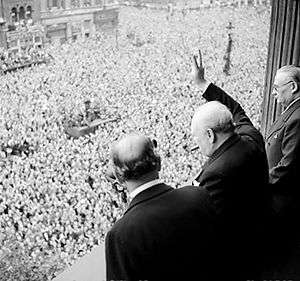Operation Hope Not

Operation Hope Not was the code-name of a funeral plan for Winston Churchill that started in 1953, twelve years before his death in 1965.[1][2] The detailed plan was prepared in 1958. As a Prime Minister of the United Kingdom, Churchill led the country to victory in the Second World War (1939–1945). He suffered from a stroke in 1953, after which his death was greatly feared. The British government started a meticulous preparation, as publicly decreed by Queen Elizabeth II to be a commemoration "on a scale befitting his position in history." The official project was undertaken by the Earl Marshal, Bernard Fitzalan-Howard, the Duke of Norfolk, to be the grandest state funeral for a person outside the royal family since that of Arthur Wellesley, 1st Duke of Wellington.[3] Churchill died on 24 January 1965, and the operation was implemented on 30 January 1965.[4] Churchill's coffin was kept at Westminster Hall. The main funeral service was held at the St Paul's Cathedral. It was transported through Thames to Waterloo, and to Bladon, Oxfordshire, where he was interred in the St Martin Churchyard,[5] near his father's tomb.[6] The funeral was the first state funeral of a British civilian in the 20th century, and at the time, recorded as the largest state funeral in the world. The official funeral lasted for four days.[7]
The plan
Operation Hope Not was prepared in its elaborate form in 1958, when the then Prime Minister Harold Macmillian took the initiatives. On 21 March 1958, the first draft of the plan titled Procedure on the Death of Sir Winston Churchill was produced.[8] In 1963, an official committee was created with the Duke of Norfolk as its chairman. The plan is a very detailed one. All activities were timed to the second. For example, gun salutes are to be given on the Havengore (the boat for transportation of the coffin on Thames) exactly for two minutes and 35 seconds. Musics are to be played exactly two minutes and 45 seconds. The procession was planned to pass through all major locations relevant to Churchill's life, including St. Margaret's Church, where he got married, and the Houses of Parliament. In the course of time the certain details of the plan were modified to suit the changing situations. According to Lord Mountbatten, the changes were necessary because Churchill "kept living and the pallbearers kept dying." A major change was the place of burial. Churchill originally willed that he be buried in his croquet lawn at Chartwell, in Kent. But since he was to be given a full state funeral, a more respectable graveyard, St Martin's Church at Bladon, was chosen.[1] The final document was completed on 2 November 1964,[8] and consisted of 200 pages.[9]
Funeral service
Churchill died on 24 January 1965, and his coffin was kept lying in state in Westminster Hall from 27 January.[8] The funeral service was on 30 January 1965. The service was performed by more than 1,000 people. Nine military bands played, and the procession included troops from 18 military units. The service started with the chiming of Big Ben at 9:45 a.m. The clock was muted for the rest of the day. 90 shots of cannons were fired at the Hyde Park to mark the years of Churchill's life. Procession started upon a drum beat, and was led by the Royal Navy. Four majors of the Queen's Royal Irish Hussars were employed to carry Churchill's medals, orders and decorations.[7] After an hour, the main service was held at the St Paul's Cathedral. Government officials (including six monarchs, six presidents and 16 prime ministers) from more than 112 countries attended.[7]

After the church service, the Churchill's casket was carried en route the Tower of London where the Royal Artillery fired a 19-gun salute. The casket was transferred to the Havengore for a short sail up the River Thames. As the boat sailed, 16 Royal Air Force fighter jets flew above in formations,[7] and shipping cranes bowed on the banks.[2] From the Waterloo Station, the casket was carried by a specially prepared train, the main engine of which was named Winston Churchill, to its final destination in Oxfordshire.[10] Churchill was interred in the St Martin Churchyard, in a private family ceremony. He was laid in a grave near to his parents and brother.[11]
Gallery
-

Churchill's coffin carried out by Royal Navy.
-

Sir Winston Churchill's coffin being lifted to the Westminster Abbey by the pallbearers.
References
- 1 2 Dockter, Warren (30 January 2015). "Winston Churchill's funeral was 12 years in the planning". The Telegraph. Retrieved 27 May 2016.
- 1 2 Bennett, William J. (2007). America the Last Best Hope. Volume II. Nashville, TN (US): Thomas Nelson Inc. pp. 376–380. ISBN 978-1-41853-110-2.
- ↑ "Operation Hope Not". Churchill College Cambridge. 21 January 2015. Retrieved 27 May 2016.
- ↑ "Operation Hope Not". ChurchillCentral. Retrieved 27 May 2016.
- ↑ "Sir Winston Leonard Spencer Churchill". Find A Grave. Retrieved 27 May 2016.
- ↑ "St Martin's Parish Church. Bladon. Oxfordshire.". The Churchill Society. Retrieved 27 May 2016.
- 1 2 3 4 Klein, Christopher (30 January 2015). "Winston Churchill's Funeral, 50 Years Ago". History. Retrieved 27 May 2016.
- 1 2 3 Hargreaves, Gareth (25 March 2008). "Operation Hope Not". 50connect. Retrieved 1 June 2016.
- ↑ Wilkes, David (22 August 2007). "Winston Churchill funeral plans go under the hammer". Mail Online. Retrieved 1 June 2016.
- ↑ "Churchill's final journey". National Railway Museum. Retrieved 30 May 2016.
- ↑ Addison, Paul (2006). Churchill: The Unexpected Hero. Oxford: Oxford University Press Inc. p. 245. ISBN 978-0-19-929743-6.
External links
- Operation Hope Not and funeral service documents at the College of Arms
- Original BBC footage of Churchill's funeral
- Documentary pictures at Slideshare